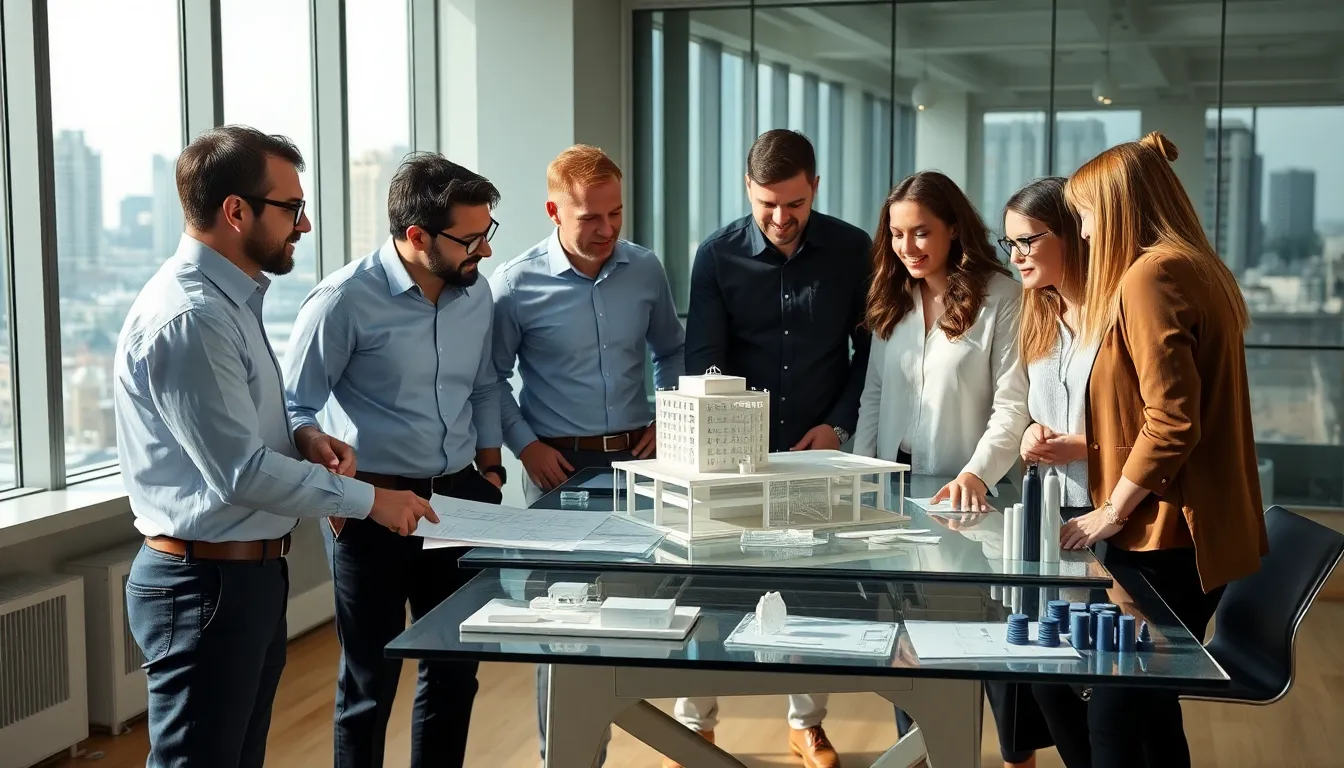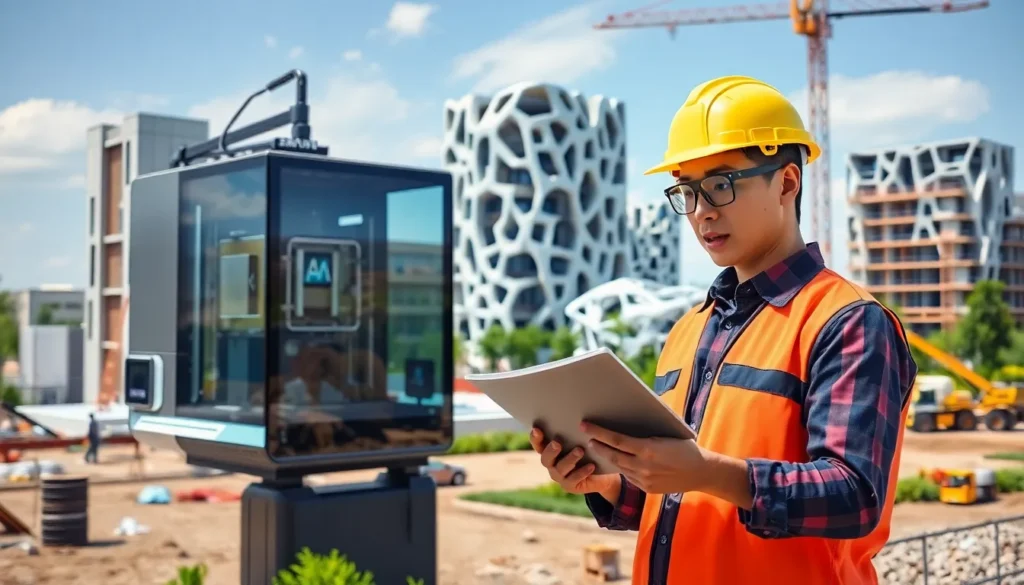Table of Contents
ToggleIn a world where buildings sprout like mushrooms after a rainstorm, impression 3D architecture is the game-changer everyone’s buzzing about. Imagine a construction process so sleek and efficient that it makes traditional methods look like they’re still stuck in dial-up internet days. This innovative approach doesn’t just create structures; it crafts masterpieces, blending creativity with cutting-edge technology.
Understanding Impression 3D Architecture
Impression 3D architecture transforms the construction landscape. It integrates cutting-edge technology with creative design, reshaping how buildings are conceived and executed.
What Is Impression 3D Architecture?
Impression 3D architecture involves utilizing three-dimensional printing methods to create architectural structures. This approach enables designers to construct complex forms that traditional methods strain to produce. Various materials, including concrete and plastics, can be used in this process. Architects and engineers collaboratively engage in crafting these innovative structures, often resulting in reduced waste during construction.
Key Features of Impression 3D Architecture
Impression 3D architecture offers several significant features that enhance building processes. It allows for rapid prototyping and quick construction times, often completing projects in a fraction of the time required by conventional methods. Customization plays a major role, enabling unique designs tailored to specific needs. Cost efficiency emerges as another advantage, as it reduces labor and material expenses. Sustainability also prevails, as this method minimizes waste and energy consumption during construction.
Benefits of Impression 3D Architecture

Impression 3D architecture offers significant advantages that enhance the overall construction process. This innovative approach creates stronger synergies between design and function.
Cost-Effectiveness
Cost-effectiveness stands out as a primary benefit. Reduced labor requirements lead to lower expenses. Material waste decreases significantly because precision printing minimizes errors. Short construction times also contribute to savings, allowing projects to complete faster than traditional methods. This efficiency doesn’t compromise quality; instead, it ensures that budgets align more closely with final outcomes. With these combined factors, companies can allocate resources more effectively and maximize the return on investment.
Design Flexibility
Design flexibility presents another compelling advantage. Architects can explore intricate shapes and complex geometries that traditional methods may limit. Customization options expand, enabling unique architectural features without prohibitive costs. Adjustments during the design phase become less cumbersome, allowing for rapid prototypes to reflect changes swiftly. Collaborative efforts between architects and engineers thrive in this environment, fostering innovation in design that appeals to varied clients. Overall, impression 3D architecture enhances creative potential while maintaining practicality.
Applications of Impression 3D Architecture
Impression 3D architecture offers diverse applications across various sectors, effectively changing how structures are built.
Residential Projects
Residential projects benefit significantly from impression 3D architecture. Architects design unique homes tailored to clients’ needs, accommodating various preferences. Rapid construction techniques expedite the building process, resulting in quicker turnarounds for homeowners. Customization options allow for intricate designs that reflect personal styles. Sustainability practices are embedded in these projects, reducing the environmental impact through minimal waste. Cost savings are noticeable due to lower labor requirements and efficient use of materials. Moreover, prototypes enable homeowners to visualize spaces before final construction decisions, ensuring satisfaction throughout the building journey.
Commercial Projects
Commercial projects leverage impression 3D architecture to enhance efficiency and design quality. Businesses gain flexibility in creating visually striking structures that stand out in urban landscapes. Advanced technology allows for the construction of complex geometries, encouraging creativity in commercial designs. Quick assembly times offer businesses the advantage of reduced downtime and faster occupancy. Integrating sustainable practices minimizes energy consumption and construction waste, appealing to eco-conscious clients. Cost-effectiveness improves profit margins while ensuring high standards of quality. Overall, impression 3D architecture revolutionizes the commercial sector by delivering innovative solutions that cater to evolving market demands.
Future Trends in Impression 3D Architecture
Impression 3D architecture is set to continue evolving, driven by emerging technologies and sustainable practices. This evolution shapes the future landscape of construction, emphasizing efficiency and creativity.
Innovations in Technology
Rapid advancements in technology play a crucial role. Artificial intelligence enables smarter design processes, while robotics streamline construction. Moreover, improved materials, such as high-strength composites, enhance structural integrity. New software tools facilitate collaboration among architects and engineers, reducing design flaws. Another trend is the integration of augmented reality for visualizing projects in real time, allowing stakeholders to engage deeply with designs. These innovations will lead to unprecedented efficiency, speeding up project timelines and reducing costs.
Sustainable Practices
Sustainable practices are gaining momentum within impression 3D architecture. Materials like recycled plastics and bio-based composites minimize environmental impact. Utilization of energy-efficient printing processes significantly conserves resources. Additionally, the ability to customize designs reduces waste, as architects can optimize materials based on specific needs. Furthermore, sustainability extends beyond sourcing materials; it influences overall building lifespan and energy efficiency. These practices lead not only to eco-friendly structures but also to cost savings in the long term, appealing to developers focused on sustainability.
Impression 3D architecture is reshaping the construction industry by merging creativity with cutting-edge technology. This innovative approach not only enhances efficiency but also fosters sustainability and design flexibility. As architects and engineers collaborate more effectively, the potential for unique and complex designs expands, leading to artistic masterpieces that challenge traditional norms.
With rapid prototyping and quicker construction times, this method is proving to be a game-changer for both residential and commercial projects. As the industry embraces advancements like artificial intelligence and augmented reality, the future of impression 3D architecture looks promising. It’s clear that this technology will continue to drive innovation and sustainability in construction, paving the way for a new era of building design.




